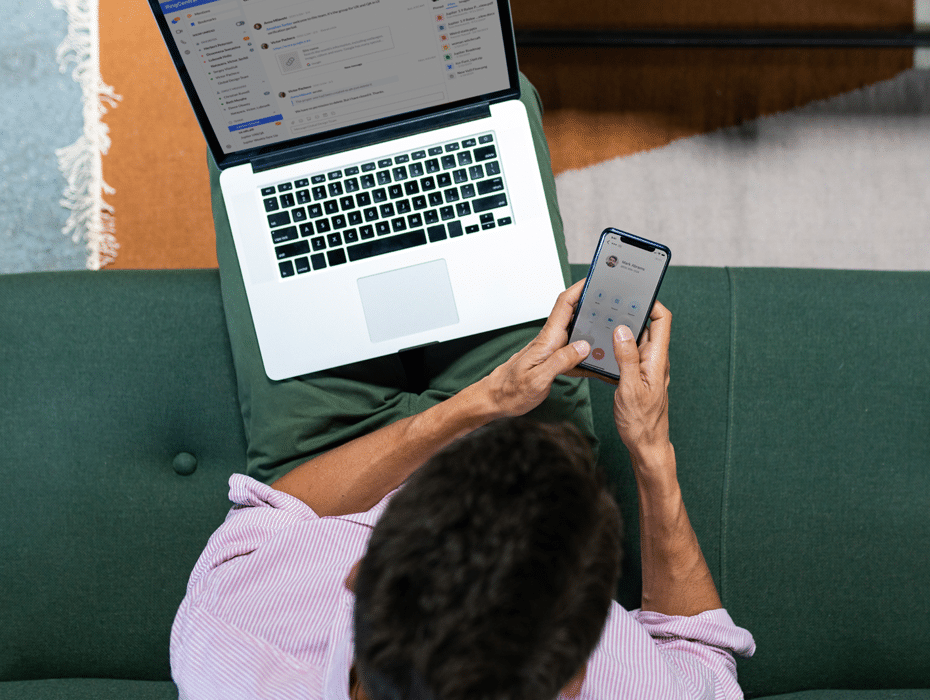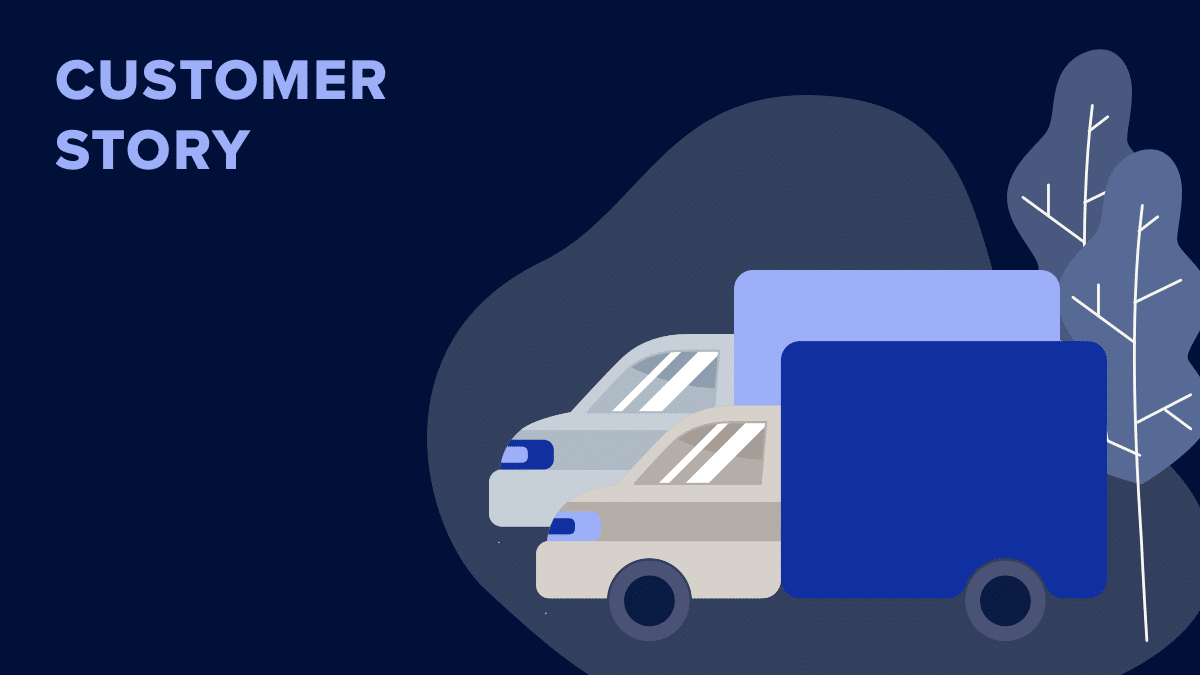If you’re someone who frequently eats at restaurants, you likely have the habit of tipping servers.
Have you thought about why you tip some servers generously—while guarding your pockets with others?
The answer might have to do with the psychology of customer follow-ups. Let’s look at a typical dining experience.
Usually, diners tip more in return for a good service experience. Isn’t it nice when the server comes to “check on” you or to see if “everything is okay” from time to time?
It also means that you might be a bit more generous when the time comes to choose a tip amount on the credit card machine, especially if the server was friendly, attentive, and prompt when following up with you on your order.
What’s surprising is that—in customers’ books—this kind of service ranks even higher than the quality of food1.
And that explains why following up with your customers, even if you’re in the business-to-business (B2B) domain, might be as important (if not more important) than just having a well-rounded product or service.
In this post, we’ll cover:
- Why it’s important to follow up with customers
- 3 approaches for following up with customers
- 13 templates to inspire your customer follow-ups
- 7 examples of customer follow-ups from real-life companies
Start closing more deals. Grab the free outbound sales playbook.
Why is it important to follow up with customers?
Everybody loves good follow-up stories.
It’s probably the reason why we love our high school reunions, the conspiracy theories around the missing of flight MH370, or a celebrity’s fate after a scandalous exposé.
In business, a sales or service follow-up is critical to maintain good customer relations, build trust, and close more sales.
Think about that for a second.
All the things that help your business grow—branding, sales, and customer service—have one thing in common. They all require great follow-up.
It’s a process of reconnecting with customers who have crossed paths with your brands at some point in time.
Take business-to-business (B2B) sales, for instance. On average, an inbound sales team has to have close to eight touches2 before they can make a sale. It’s tough to crack B2B sales given the longer and more complicated nature of B2B buying cycles.
Or maybe you’ve heard that oft-quoted stat about 60% of prospects saying “no” four times before saying “yes.”3
And to be fair, keeping up with prospects is a rarity among most brands. That’s why about 44% of salespeople give up prospecting a customer after just one follow-up call.4
Honestly, selling to B2B prospects sounds an awful lot like courting your hard-nosed love interest.
But what most suitors—the sales folks—don’t realize is how close they are to making a sale if they just follow up a few more times. Sometimes, it’s as simple as hitting that “Send” button or picking up the phone and saying hi.
And that’s just in sales. The benefits of following up with your customers can be enormous to other aspects of your business, such as in customer service.
Just the mere gesture of giving an after-sales courtesy call to your customers or sending them a thoughtful flower bouquet during their moment of grief5 can turn your customers into your brand’s lifelong fanatics.
3 ways to follow up with customers
Following up with customers is nothing but a way to see through things that were left half-done. It’s like coming up with a sequel for a mystery novel to justify the intriguing plot that was unfinished in the first novel.
And it’s actually a pretty straightforward process. All you have to do is figure out what were the gaps in the original story and how you can make it whole again.
In other words, complete the communication that you started. Put it that way, customer follow-up is an art.
But you need some robust technological scaffoldings to paint the full picture. Everything about making your customer follow-up work circles back to having an effective system of communication with your customers.
So from improving your conversions to offering remarkable customer service, here are three best ways to follow up with customers:
1. Use the classic approach of touching base
“Touching base” has become an abomination in sales circles because of how overused it has become. But it can still work—if you do it right.
Most sales teams can’t function without sales apps like a customer relationship management (CRM) software. That’s where they record all their customer data: the prospects who are evaluating them, prospects who fell off their radar, and the prospects that said no.
Despite that goldmine of data sitting in their CRM, salespeople don’t always follow up consistently with prospects who can convert into customers.
Following up with prospects—one of the most important things they should be doing—doesn’t feature in their plan6 at all. Don’t let this be the reason that you’re missing your quota.
But it’s not entirely salespeoples’ fault. They’re usually not very keen to reach out to leads simply because 42% of sales reps don’t have enough information to follow up with prospects.
You can’t follow up effectively with customers when you don’t know what’s more relevant for them: did they want a demo, were they evaluating the pricing, or did they just need more time? That’s why just popping-in to say “hi” without context tends to be a bad follow-up strategy.
Luckily, there are ways to streamline your sales follow-ups with more context and confidence.
For instance, if you’re in the real estate business, you might be using a CRM like Follow Up Boss.
You can integrate Follow Up Boss with RingCentral to trigger a follow-up reminder when a prospect books a new appointment on your website, hangs up the phone, or sends you a text message.
You can also create similar reminders based on your sales team’s actions such as adding a new contact in the phone book, recording a phone call, or updating a deal stage.
When it’s time to follow up, now you’re equipped with more knowledge about your prospect’s last interaction with your brand. And that’s just an example of a real estate use case.
The point is, you can connect your CRM with your communication platform to do most of these things:
- Place calls directly from within the CRM
- Log phone calls automatically to your CRM
- See the contact history of the caller when a prospect calls
- Send automated voice messages to your leads and customers
- Take call notes, save them to your activity log, and schedule follow-up calls
2. Play to the Zeigarnik effect
If you’ve never heard of the Zeigarnik effect before, you’re going to love this psychological hack.
According to GoodTherapy:
“The Zeigarnik effect is a psychological phenomenon describing a tendency to remember interrupted or incomplete tasks or events more easily than tasks that have been completed.”
Let’s understand this effect with the help of a relatable analogy.
Think of the time you went to watch a movie after watching an intriguing movie trailer. Although the teaser gave you a fair idea about what the movie was about, you rushed to the theaters on the first day of the movie release because of the critical clues the promo (deliberately) left out.
The same effect kicks in when we become restless to finish everything on our to-do list. Or, when we binge-watch a suspenseful web series in one sitting because each cliffhanger leaves us wanting for more.
Marketers use the Zeigarnik effect to launch retargeting ads or send abandoned cart emails because it guilts people into completing their half-finished purchases.
The Zeigarnik effect is effective because when you don’t heed to that annoying reminder or a half-baked thing in the back of your head, it will persist longer and irritate you until you follow through.
Figure out what are the gaps your customers’ are leaving in their interactions with your brand and sprinkle a little Zeigarnik effect to charm them into completing that process with you.
For instance, if you offer free trials but your lead-to-conversion rate is struggling, start an email nurturing campaign. Follow up with customers to check what’s stopping them from upgrading to a paid plan.
3. Give them a personalized customer service experience
If follow-ups in sales mean more business, then follow-ups in customer support mean more repeat business.
Just like in our earlier restaurant example, even a routine “was everything okay?” check-in from a brand representative can make a world of difference to our overall experience.
So what can your brand do?
Among many other things, make sure the follow-up experience is uniform and personalized for all customers. It’s easy to forget to call your customers or send them an email once a sale is made or a support ticket is closed.
So, you could automate your customer service after the sale for efficiency, scale, and consistency. Or schedule an autoresponder email with a personalized thank-you note one hour after a customer purchases your product.
How about sending them a customer feedback form 24 hours after every service interaction to make them feel valued or to create a direct feedback loop with them?
Although this follow-up approach sounds like a good ending to a customer service experience, it’s far from being over.
Ideally speaking, a great customer experience coupled with a fitting service follow-up usually translates into more returning customers. But you can’t always leave things to chance; you can control the likelihood of making customers return to an extent.
There are several ways to automate phone calls to offer a memorable customer service experience. For example, you can connect your customer survey to your CRM software so that you can plan a new nurture campaign for past customers based on their answers.
Your relationship with customers doesn’t stop once they buy something from you. But it’s up to you to keep up with them and find possible avenues to re-engage with and retain customers (or upsell and cross-sell your services to them).
13 templates to inspire your customer follow-ups
First of all, we have to clarify some air around the use of templates.
Templates are a double-edged sword. You can use them for efficiency so that you don’t have to spend a lot of time and money to decide what to say to customers during a follow-up.
Scripting templates also makes your brand communication consistent and helps you scale the process.
On the other hand, relying too much on scripted templates can kill personalization and make your customers feel like you’re just blasting your whole email list with the same message, which might discourage them from bothering to respond to you.
And more often than not, it’ll look bad for your brand if you accidentally send out an unfinished template to scores of customers.
Be flexible in using templates. If, for example, a service follow-up requires a high-touch interaction, break the rigid barriers of following a script and add a custom message specific to that customer.
And don’t forget to tweak your follow-up templates from time to time to keep your brand communication fresh.
But when time or volume is of essence, feel free to take inspiration from the follow-up templates below.
Sales follow-up templates
Email remains to be one of the most important outreach channels to increase sales. But you have to be persistent about it.
Here’s first-hand data from Yesware—a sales productivity platform—on the kind of response they got from leads when they launched a 10-step email follow-up campaign:
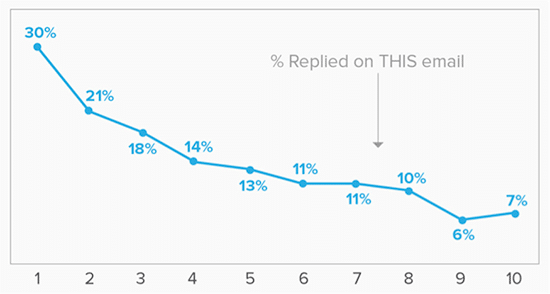
Notice how the response rate got lesser and lesser over time, but even the 10th email got a 7% response rate.
One trick to make your sales follow-up better is to offer value to customers. A follow-up without an incentive doesn’t rank on top of your customers’ inboxes.
Here’s an email sales template of how to entice a long-lost customer to talk to you again.
Sales follow-up email template:
Subject line: {{Name}}, I have something to show you.
Hey {{Name}},
I’m reaching out to you because {{you recently downloaded our eBook on how to generate leads for e-commerce}}.
Over the last {{3 months}}, I have helped {{10 e-commerce brands}} like yours {{increase their website traffic by up to 40%}}.
I have {{similar ideas}} for {{e-commerce store name}} to help you {{get more traffic}} and {{increase sales}}.
Would you be interested in {{hearing those ideas}} some time next week? Let me know.
Best,
{{Name}}
{{Direct phone}}
It’s short and sweet and has a relevant offer that aligns well with the customer’s pain points. But what if they don’t reply?
There isn’t one universal answer to how often should you follow up with a customer. On average, it’s nice to check with them after 2–4 days since your last email.
If you have the customer’s phone number, send them a text message. An SMS is not much different in the sense that it’s text-based, linkable, and customers can reply at their own convenience.
Here’s a template to follow-up with customers via text message:
But suppose your email bounces back or the message is too long to convey, don’t hesitate to pick up your phone and give them a call. Here’s an easy script for you to do that:
Sales follow-up phone script template:
“Hi {{name}},
This is {{your name}} from {{your company}}.
I’ve been thinking more about how I can help your company {{generate more leads and improve sales}} for {{their business name}}.
I think you’d be interested to know how I helped {{brand A and brand B}} achieve those goals.
It’s okay even if you aren’t looking to purchase anything from us right away.
But I’d love to share these insights with you over a 15-minute call.
Are you free this Thursday or Friday around noon to discuss this in more detail?
Remember that unlike an email or a text message, a phone call can’t be a monologue.
Be sure to let your customers speak to complete the above script. Unless, of course, you reach the customer’s voice mail—in which case you can record a short message in one go.
A multichannel follow-up approach is always better than relying on just one channel. Sometimes, an ambient approach is what it takes to get a response from a customer.
If you still want to take the email route, here’s a sample follow-up email to touch base with customers who didn’t respond to your previous email.
Sales follow-up email template:
Subject line: Did you get my last email?
Hi {{Name}},
I just wanted to see if you have had any chance to go through the previous email that I sent over last Friday.
If you didn’t, no worries. I’m threading it below this email so that you can go over it.
If it sounds interesting to you, let me know so that we can set up a meeting at your convenience.
Best,
{{Name}}
{{Direct phone}}
Here’s a bitter reality check. After trying out for the 11th time, you’ve to take the hint. Your emails are either landing on the spam folder or the customer is not interested in what you have to sell.
In this kind of situation, it’s okay to do a Hail Mary and see if you can break up with hard-to-please customers. You can invest that time in prospecting other clients.
Sales follow-up email template:
Subject line: It’s okay to say no.
Hi {{Name}},
It looks like you’re 1) not getting my emails, 2) not interested in my offer, or 3) too busy to reply.
And I want to make this very simple for you.
If you’re reading this—can you reply to this email either with 2 or 3 based on the options above?
Best,
{{Your Name}}
{{Direct phone}}
You can replicate this follow-up message via SMS because prospects are more likely to reply to text messages with preset replies. For instance:
But be careful when you’re making a last-ditch effort. It can sound cold or passive-aggressive. At that point, it’s not about just losing a customer but avoiding making your brand look bad in public.
Customer service follow-up templates
Let’s start with what makes a service follow-up email click.
It’s usually best to send an email 24–48 hours after a customer purchases your product and schedule an automated email to let them know you are there to help them in case they need any help.
Customer service follow-up email template:
Subject line: Hi {{Name}}, just checking in to see you’re enjoying your new {{your product name}}.
Hi {{Name}},
I hope you like your recent purchase with us.
I just wanted to reach out and say that if you have any questions, complaints, suggestions—just about anything—you can let us know directly.
And yes, you can reply directly to this email or {{click here}} to fill out a short survey form (won’t take more than 2 minutes, I promise).
Once again, thank you for shopping with {{your brand name}}!
Thanks,
{{Your name}}
{{Support helpline}}
Notice how the copy says the customers can reply directly to the email. This is to assure the customer that it’s not a randomly automated email, but a message that was written with them in mind.
You can always streamline the replies to your helpdesk software to categorize issues that need following up. Here’s an SMS template for a similar use case:
Customer service follow-up SMS template:
A phone call for the above scenario can be pretty amazing since a lot of companies don’t follow up with customers right after a sale. Here’s how you can script such a call:
Customer service follow-up email template:
Hello {{Name}},
This is {{your name}} calling from {{your company}}.
I know you brought {{product name}} from us recently.
So I wanted to give you a quick call and let you know that if you have any questions or if you need any help from us, we’re just a phone call away.
If you prefer, you can get in touch with us through email or chat from our website too.
Once again, thank you for shopping with us. Have a great day ahead! Thank you and bye-bye.
Which customer wouldn’t love hearing a brand calling to check on things, right?
You also have the option to automate a robocall for doing this if bandwidth is a problem. But we recommend assigning a dedicated rep who has proven customer service skills to carry out this job for giving a human touch.
Another way to delight a customer is to follow up with them after a service interaction to measure your customer satisfaction (CSAT) or Net Promoter Score (NPS).
Here’s an easy email template for you to help with that.
Customer service follow-up email template:
Subject line: Hi {{Name}}, did you find everything alright?
Hi {{Name}},
You recently contacted us to {{cancel your payment}}. I’m following up to see if you were satisfied with the quality of our customer support.
How happy are you with the way we handled your issue?
[Extremely Happy] [Happy] [So-So] [Unhappy] [Extremely Unhappy]
Thank you for being a valued customer of {{your brand’s name}}.
Regards,
{{Your Name}}
Here’s an alternative text message template for the above scenario:
Customer service follow-up SMS template:
Customers always love an email that says their issue was taken care of. Like this one:
Customer service follow-up email template:
Subject line: Hi {{Name}}. Your refund is on its way.
Hi {{Name}},
I’ve processed your refund of {{$25}} that you paid for {{product name}. You should have the money appear in your bank account in 3–5 business days.
I understand that you had issues with {{the product}}.
In case you’re still looking to buy {{the product}}, you can {{browse our collection}} again to find a few more options that fit your needs.
Once again, thank you for shopping with us.
Best,
{{Your name}}
By offering a prompt solution to their problems, not only do you restore a customer’s faith in your brand but you give them the confidence to do business with you again.
Sending customers text messages on their birthdays or anniversaries is yet another way to stay in your customer’s shopping radius:
Customer service follow-up SMS template:
7 examples of customer follow-ups from real-life companies
Below, we have curated a list of six examples of follow-up emails and text messages from real-life businesses.
Each example covers a specific aspect of the customer follow-up process that we discussed in the previous sections.
Let’s start with Anne, who’s a business coach for startup founders, CEOs, and investors. She’s using the standard follow-up style touching base with a prospect she met at an event.
Sales follow-up email example:
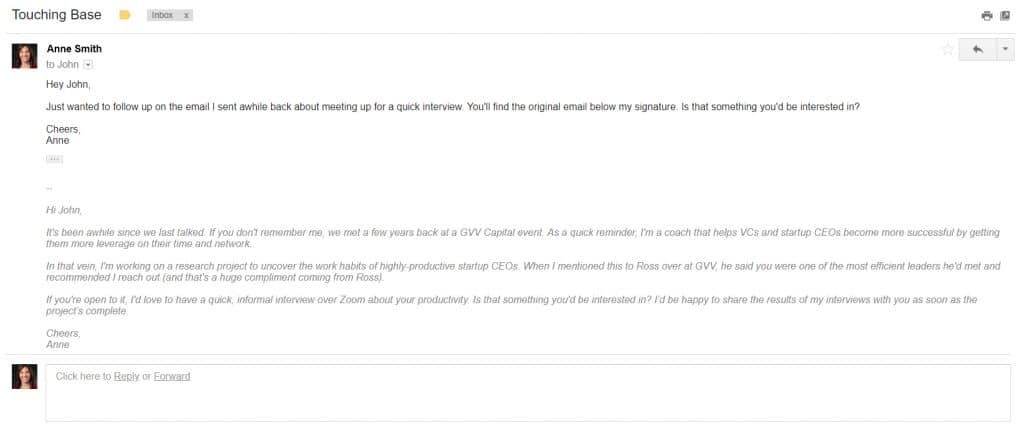
[Source]
What’s great about the above email is that it’s brief and Anne has included the previous email to John—the recipient—to jog his memory about their last meeting.
But if the customer doesn’t respond to your first few emails—how do you politely follow up? Here’s how Anne followed up with John after a few days.
Second follow-up email example:

[Source]
Anne is consistent with keeping her message short, friendly, and empathetic. She doesn’t come across as someone who’s pushing it, but someone who’s politely persistent.
Third follow-up email example:

[Source]
Anne certainly knows the art of persevering. The above email is likely her last try to John, but she still maintains her composure and gives John a few options.
We don’t know how this story ended, but what we know is Anne’s emails are some of the best examples we have seen about following up with your prospects for sales.
Here’s a similar type of sales follow-up, but sent through a text message.
SMS follow-up example:

[Source]
This sender is playing up the Zeigarnik effect by showing Jimmy the tip of the iceberg while keeping the best information for later.
We also love how this real estate company below follows up with its prospects soon after they contacted the brand.
SMS follow-up example:
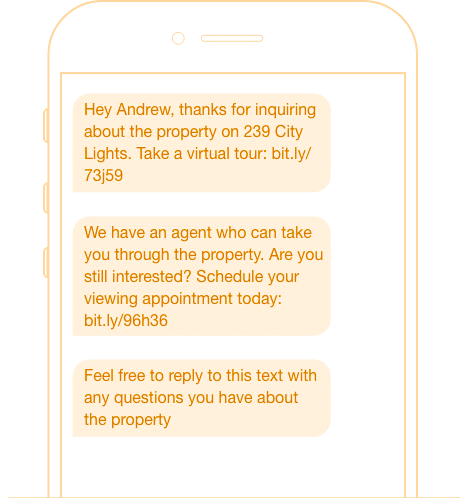
[Source]
There’s a link to a virtual tour, a high-touch possibility of talking to an expert agent, and plenty of room for interacting through the text message itself. What’s not to love about this follow-up?
Enough about sales prospecting.
Here’s one of our favorite examples of a customer service follow-up text message from HomeWare, who’ve since rebranded themselves as Hooker Furniture.
Customer service follow-up via SMS:
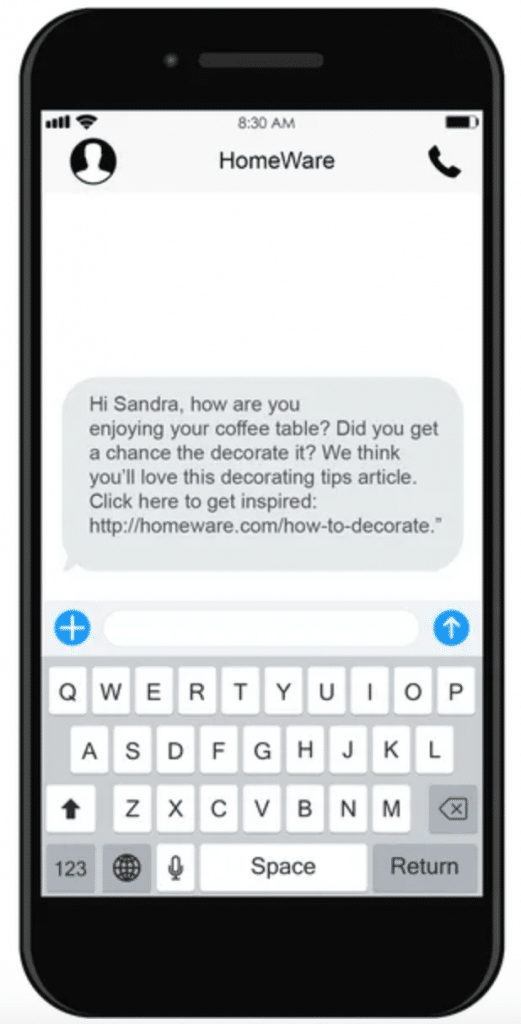
[Source]
It feels more like a text from a friend of a relative than a brand. It’s personal, caring, and genuine because there’s no expectation of an immediate exchange at this point.
Instead, by sending a blog that will help the consumer decorate her coffee table, the brand went the extra mile to ensure Sandra feels taken care of.
Finally, there are very few brands that make customer feedback and surveys are as fulfilling as Uber.
The message is to the point, personalized to the customer’s most recent purchase, and it’s considerate about the customer’s time. Take a look:
Customer service email follow-up:
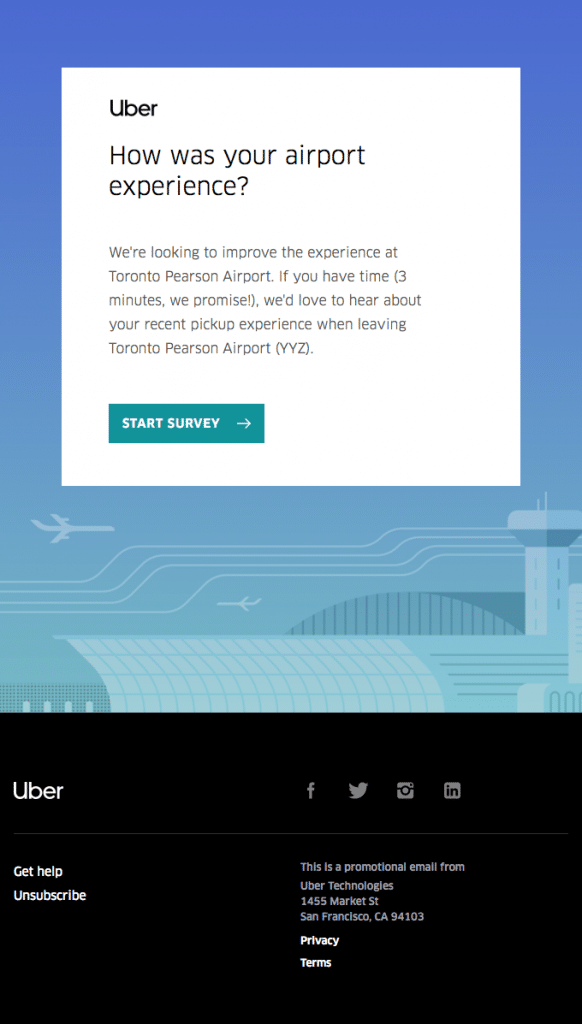
Amp up your customer follow-ups
When Superoffice ran a survey among sales teams a few years back, they found this conclusive data:
Thirty percent of the sales professionals surveyed said that following up with prospects is the third biggest challenge for sales teams everywhere.
That goes on to show how rare customer follow-up is across industries. And it’s not too different in the context of customer service too, where following up with customers gets a step-motherly treatment.
Our parting tip? Fortune favors the ones who follow-up flawlessly with customers. Incorporate follow-up as an integral part of your sales and customer support strategy to unlock the business potential that is hidden in plain sight.
1 https://www.semanticscholar.org/paper/What-Motivates-Restaurant-Customers-to-Tip%3A-from-Kvasnicka/1a22840ce512ae7b743e214e9045fda877b2a7782 hosteddocs.emediausa.com/Sales-Development-Benchmark-Report-Sponsored-By-Outreach.pdf
Originally published Mar 16, 2020, updated Jun 20, 2024
